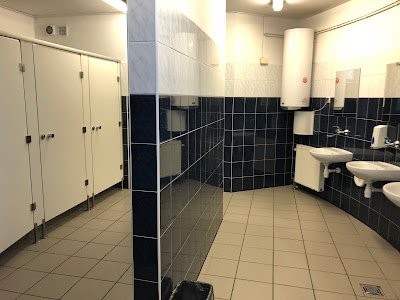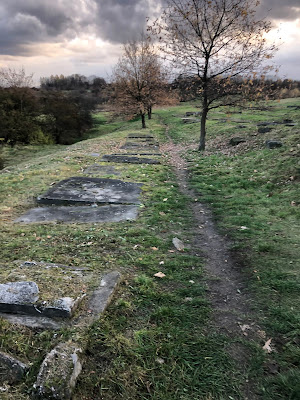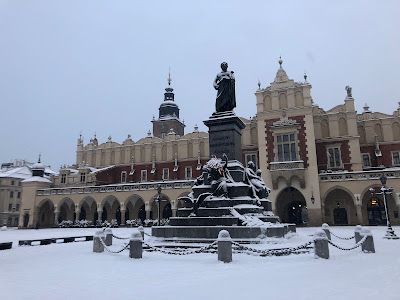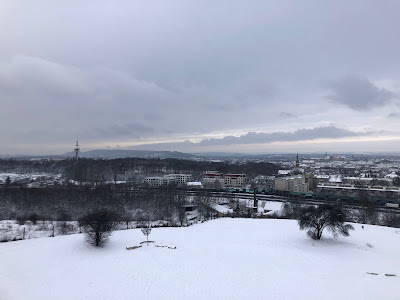Most people who want to experience a concentration camp while visiting Krakow go to Auschwitz. And for good reason, too. Auschwitz is probably the most recognizable name of any concentration camp and it's only an hour west of Krakow. Although I haven't been yet, I know that visiting Auschwitz-Birkenau is an immersive experience and makes it onto the to-do list of any history-savvy Krakow visitor. But, even though most tourists won't hear about it, Krakow is home to its own Nazi concentration camp within the city limits: the Krakow-Płaszów concentration camp ("Płaszów").
Unlike Auschwitz, the former structures of Płaszów have not been kept up. The only buildings that still remain intact on the property are the Grey House, a former Jewish-owned building-turned to Nazi offices and jailhouse in 1942, and Amon Göth's villa, which is easy to miss as it is not marked by any signage and its renovations camouflage it with surrounding neighborhood homes. The rest of the grounds are now considered a memorial park and nature preserve with large open fields and lightly wooded hills. As you walk around the park (~80 hectares now, but at its largest the camp covered ~150 hectares), there are informational signs, a few memorials and monuments, some rubble, and typically a smattering of people taking their dogs and families for walks. You don't see much indicating that the land used to be surrounded by an electrical barbed-wired fence with guard towers nor that train tracks used to run through the property.
It really is quite peaceful, which makes it difficult to reconcile the idea that 40,000 prisoners were there between the years of 1942-1945, with a max of 25,000 at one time (not including those who passed through as a transit camp). The site itself had previously been two Jewish cemeteries, and after a month of renovations (i.e. knocking over the gravestones and using slave labor to erect shanty living quarters) the Krakow Jewish ghetto was liquidated and those fit for work were transferred to Płaszów. Although the camp was initially intended to house Krakow Jews, it also imprisoned a large number of Hungarian Jews, Roma (Gypsies), and Polish prisoners (largely from the Warsaw Uprising).
It was used as a labor camp, with a high concentration of women and children compared to other work camps. Although children were allowed there (at least in the beginning) they had to pull their weight, too. The hardest labor was working in the nearby quarries while children and the elderly tended to work as brush makers. Other labor included: sewing uniforms, electrical and automotive work, printing documents, and serving in armament factories, among other things.
While some inmates stayed at the camp indefinitely (typically just a few months given the harsh labor conditions, starvation, typhus, and sadistic commander), for others it was merely a stop on the way to be killed at Auschwitz. That proved to be the case for many of the children. As one of the signposts indicates, in 1944, the Commandant Amon Göth declared that all of the children would be sent to "kindergarten," which truly meant that they were rounded up and sent to be gassed the next day.
Göth was a brutal character. He started his first day at camp in February, 1943 by killing two of the camp's Jewish policemen, and then every day thereafter he shot at least one person before breakfast. In addition to regular shootings (it is thought that he singlehandedly murdered around 500 prisoners), hangings were common, and Göth also trained his two dogs (a Great Dane and a German Sheppard mix) to tear prisoners to death. He was also fond of collective punishment and mass murders. Göth stayed at the camp until September, 1944, when the Nazi Party charged him with theft of property (one of the roles at Płaszów was to sort through the gold and other valuables that were collected from the imprisoned and dead), violation of camp regulations & prisoner punishment, and failure to provide adequate food to the prisoners. After the war, he was tried by the Supreme National Tribunal of Poland and was hanged in Krakow in September, 1946.
Though each of the 19 main informational signs have a quote from a Płaszów survivor and a small paragraph of information, they gloss over the true hardships of living in Płaszów (you know it was bad if the Nazi government decided the commander was being too brutal). Largely due to Göth's influence, Płaszów had one of the highest death rates of any labor camp. A typical week might consist of three or four truckloads of new laborers to replace those condemned to mass execution. As described by Halina Nelken, who was at Płaszów as a 20-year-old, the condemned were walked into a trench, ordered to strip naked, shot, and then covered with dirt as all other inmates watched.
Clearly, fear was ever-present, as was hunger. One of the quotes posted in the park is from Aren Blumenkranz: "And, really they were getting maximum productivity out of us. We should have had a free Sunday once for three weeks, but just on that day a wagon of coal to be loaded was arriving or another job was found for us so time off was out of the question. Our food for a 12-hour working day was 1.4 kg of break weekly and 1 litter of thin soup daily." Those who worked as Jewish police at the camp were given double rations of thicker soup and more bread of higher quality, but they then were tasked with whipping fellow inmates (lashings were a common punishment). Once Göth was replaced, diets began to occasionally include eggs, sugar, and powdered milk.
Surprisingly to me, there was also some outside help. A few support groups and individuals were tolerated by the Germans and provided additional food and medicine to the camp. Some prisoners were employed outside of the camp (at Oskar Schindler's factory, for example), and could exchange their wages (which was by no means a required exchange for their labor) for additional food rations. While the extra nutrition was necessary, those found with smuggled items, even an extra piece of food, were subject to whippings or death.
Those who are familiar with Schindler's List will recognize the concentration camp's name. If you look on a map, you'll see that Oskar Schindler's factory sits about 2km from the Płaszów SS Headquarters. A significant portion of the Jews that survived Płaszów were contracted out as staff at the enamel factory. For the movie, Steven Spielberg elected not to use the actual Płaszów site in order to leave it as is and honor the memory of its victims. The scenes that you see in the film are reconstructions built inside the Liban quarry (which actually was used for forced labor for many Płaszów inmates).
The camp began to close down when threats from the Red Army became more prominent in summer of 1944. Most prisoners were deported to other concentration camps and the remaining few-hundred were tasked with breaking down the barracks and exhuming the bodies from 11 mass graves (in an attempt to hide the crimes). As documented by the Holocaust Education & Archive Research Team, it took 17 truckloads to rid the site of the human ashes. In the end, those remaining few were marched to Auschwitz to meet their ends.
Now, there are a few monuments around the park, the most prominent of which is the 7 meter "Memorial to the Victims of Fascism in Krakow," carved by Ryszard Szczypiński and designed by architect Witold Cęckiewicz. The huge limestone block is a "homage to the martyrs murdered by Nazi genocide in 1943-1945," as is carved into the back of the stone. Another prominent one is a large cross topped with barbed wire, which marks one of the execution sites. It's strange that from the main part of the park you look over at a large hardware store and the cellar of Göth's house, which used to house his maids, is now being used as a wine cellar for the family that currently lives there. I have some mixed thoughts about the modernization of things, but I'm glad that in general Krakow makes space to acknowledge its history while making peace with the idea that time moves on and things change.

There are a few of these signs on the perimeter of the park: "Dear Visitors! You are entering the site of the former Nazi German concentration camp "Płaszów". Please respect the grievous history of the site."
The barbed cross on the hill Hujowa Górka marks one of the mass execution sites. Apparently, the name is a bit of wordplay: a combination of Albert Hujar's name, who was the SS officer who ordered the first executions here, and the Polish words chujowa/chujowka/chuj, which is a vulgarity encompassing bitch/shit/prick/cock...you get the idea.
The most imposing monument is visible from the nearby main road, Kamieńskiego. Nearby the "Memorial to the Victims of Fascism in Krakow" (also sometimes known as the "Memorial of Torn-Out Hearts") are two smaller memorials to remember the Hungarian Jewish women and all Jewish women of the camp.
One of the 19 primary informational signs, this one discussing the mass executions/burials. You can also see the monolithic memorial in the background.
The biggest area of the park is made up of large flat fields. Pre-war, these were Jewish cemeteries that were plowed-down and converted to barracks and factory areas during the time the camp was in operation. It is not uncommon to see picnickers and dog walkers in these fields.
The lower end of the main field, in the south eastern end section of the park are piles of large ruble, which once were the pre-burial hall of the new cemetery of the Krakow Jewish Community. During the camp's existence, it was repurposed as a utility building that housed stables, pig farms, rabbit hutches, etc. It was partially detonated for Göth's amusement one night, and the remaining stucture was blown up in 1944 as part of the camp's final destruction.
The smaller of the two former Jewish cemeteries still has some grave markers. The Germans removed these from their original locations and flattened them to make a road in the camp. The Schindler's List replica of the gravestone road (shown in the black-and white screenshot from the movie) can be found at the bottom of the Liban Quarry.
Looking up at that cemetery, you can see that there are a fair amount of gravestone remains. These were mostly buried and became Roll Call Square, which was sandwiched between the men's and women's barracks. They were only uncovered in the 2000s as part of conservation efforts.
The Grey House is the only intact building within the memorial park grounds. The upper floors were used for administrative purposes and the basement was a prison and torture chamber. The upper photo is the original and the lower black-and-white photo is the version built for Schindler's List's set.
A view looking up from near the Grey House to the main fields. The monument you can see memorializes the 13 Jews who were murdered in the first WWII mass execution. That happened on the marked site on September 10, 1939, before it became the Krakow-Płaszów concentration camp.
Nearby, though not pictured here, is another memorial marking a pre-camp event. A new tombstone has been built marking the burial place of Sara Schenirer, the founder of the first Jewish girls school in Krakow.
I could be very wrong about this, but from the descriptions I've read I think that these remains, though technically no within the camp grounds, are the remains of the movie set-version of Amon Göth's villa and stables buildings. If I'm right, then the ring marked in the grass outlines the infamous balcony that Göth shot prisoners from in the movie. Likely that wasn't common practice in real life, given the orientation of Göth's actual house in relation to the prisoners' camp area. That being said, the black-and-white photo is of the true Amon Göth on the original home's balcony.

A map outlining the previous orientation of the camp (from https://encyclopedia.ushmm.org/content/en/article/plaszow). Unfortunately, there is nothing this detailed within the park, making it hard to visualize the historical structures.

I also like this map (from https://www.inyourpocket.com/krakow/kl-plaszow-concentration-camp-in-krakow_73759f) since it shows the location of the former Jewish cemeteries and Göth's Villa.
In some ways it is nice that the signage isn't emotionally overpowering. It allows visitors to find some peace and enjoy the landscape, if that's what they choose to do.
~~~
Normally I don't cite many resources, but since I am relying on others for the historical accuracy of this post, I want to at least share the websites that I consulted. I also am relaying information I got from the signs posted throughout the park. The specific numbers of prisoners (total and murdered) is unknown since the prisoner index was destroyed. The estimations vary across sources so I used the numbers that are on display in the memorial park or that I was seeing most commonly:
https://www.atlasobscura.com/places/krakow-plaszow-concentration-camp
https://www.britannica.com/place/Plaszow
https://encyclopedia.ushmm.org/content/en/article/plaszow
https://en.wikipedia.org/wiki/Amon_Göth#Płaszów
https://en.wikipedia.org/wiki/Kraków-Płaszów_concentration_camp#cite_note-:6-21
https://www.history.co.uk/article/the-horrors-of-the-krak%25C3%25B3w-p%25C5%2582asz%25C3%25B3w-concentration-camp
https://www.inyourpocket.com/krakow/kl-plaszow-concentration-camp-in-krakow_73759f
https://www.jewishvirtuallibrary.org/plaszow-history-and-overview
http://www.krakow.travel/en/17761-krakow-plaszow-nazi-german-concentration-camp
https://krakville.com/blog/2019/09/schindlers-factory
https://www.memorialmuseums.org/eng/denkmaeler/view/81/Memorial-to-the-Victims-of-the-Płaszów-Concentration-Camp#
https://www.timesofisrael.com/notorious-nazis-house-of-horrors-to-become-a-luxury-villa/
https://war-documentary.info/where-was-schindlers-list-filmed/







































